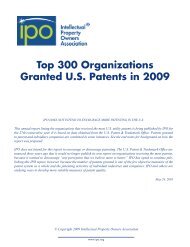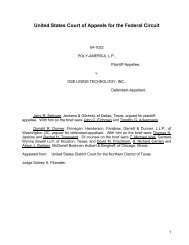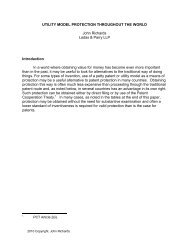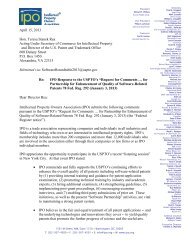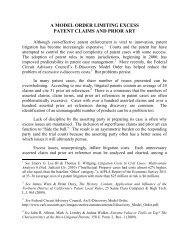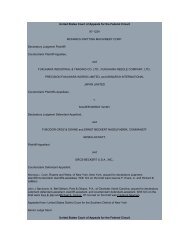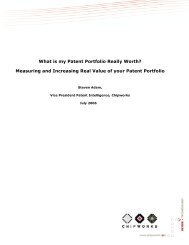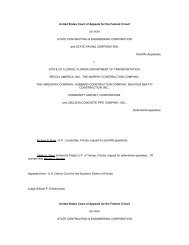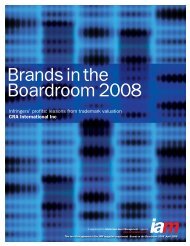IPO Comments in Response to ICANN's Trademark Clearinghouse
IPO Comments in Response to ICANN's Trademark Clearinghouse
IPO Comments in Response to ICANN's Trademark Clearinghouse
You also want an ePaper? Increase the reach of your titles
YUMPU automatically turns print PDFs into web optimized ePapers that Google loves.
January 15, 2013<br />
Mr. Fadi Chehadé<br />
Internet Corporation for Assigned<br />
Names and Numbers (ICANN)<br />
12025 Waterfront Drive, Suite 300<br />
Los Angeles, CA 90094-2536<br />
RE: <strong>IPO</strong> <strong>Comments</strong> <strong>in</strong> <strong>Response</strong> <strong>to</strong> ICANN’s <strong>Trademark</strong> Clear<strong>in</strong>ghouse<br />
“Strawman Solution”<br />
Dear Mr. Chehadé:<br />
1501 M Street, NW, Suite 1150 ● Wash<strong>in</strong>g<strong>to</strong>n, DC 20005<br />
T: 202-507-4500 ● F: 202-507-4501 ● E: <strong>in</strong>fo@ipo.org ● W: www.ipo.org<br />
President<br />
Richard F. Phillips<br />
Exxon Mobil Corp.<br />
Vice President<br />
Philip S. Johnson<br />
Johnson & Johnson<br />
Treasurer<br />
Carl B. Hor<strong>to</strong>n<br />
General Electric Co.<br />
Intellectual Property Owners Association (<strong>IPO</strong>) appreciates this opportunity <strong>to</strong> submit<br />
the follow<strong>in</strong>g comments on the new generic <strong>to</strong>p-level doma<strong>in</strong> (gTLD) <strong>Trademark</strong><br />
Clear<strong>in</strong>ghouse “Strawman Solution,” posted by ICANN for public comment on<br />
November 30, 2012.<br />
<strong>IPO</strong> is a trade association, based <strong>in</strong> the United States, represent<strong>in</strong>g companies and<br />
<strong>in</strong>dividuals <strong>in</strong> all <strong>in</strong>dustries and fields of technology who own or are <strong>in</strong>terested <strong>in</strong><br />
<strong>in</strong>tellectual property rights. <strong>IPO</strong>’s membership <strong>in</strong>cludes more than 200 companies, and<br />
approximately 12,000 <strong>in</strong>dividuals who are <strong>in</strong>volved <strong>in</strong> the association either through<br />
their companies or law firms, or as <strong>IPO</strong> <strong>in</strong>dividual members. Our members hold<br />
trademarks around the world. As such, <strong>IPO</strong> has a significant <strong>in</strong>terest <strong>in</strong> the new gTLD<br />
<strong>in</strong>troduction generally and, more specifically, the rules, requirements, and processes for<br />
safeguard<strong>in</strong>g brand owners dur<strong>in</strong>g the launch of each new gTLD registry and beyond.<br />
Overview<br />
As an <strong>in</strong>itial matter, <strong>IPO</strong> appreciates that ICANN has attempted <strong>to</strong> respond <strong>to</strong> concerns<br />
regard<strong>in</strong>g implementation of the <strong>Trademark</strong> Clear<strong>in</strong>ghouse (TMCH) and its attendant<br />
rights protection mechanisms (RPMs) that have been voiced by the trademark<br />
community. Specifically the Strawman Sollution addresses RPM Consensus Positions<br />
put forth by the ICANN Intellectual Property Constituency (IPC) and Bus<strong>in</strong>ess<br />
Constituency (BC) on Oc<strong>to</strong>ber 16, 2012. However, while the Strawman Solution moves<br />
closer <strong>to</strong> a model that fairly takes <strong>in</strong><strong>to</strong> account the problems that will be encountered by<br />
trademark owners as each new gTLD is launched, we are still concerned about the<br />
danger <strong>to</strong> companies’ valuable brands. We are particularly concerned about massive<br />
costs associated with defensively register<strong>in</strong>g key brands at the second level <strong>in</strong> hundreds<br />
of new gTLDs.<br />
Direc<strong>to</strong>rs<br />
T<strong>in</strong>a M. Chappell<br />
Intel Corp.<br />
Mark Costello<br />
Xerox Corp.<br />
William J. Coughl<strong>in</strong><br />
Ford Global Technologies LLC<br />
Robert DeBerard<strong>in</strong>e<br />
Sanofi-Aventis<br />
Gerald L. DePardo<br />
The Travelers Companies, Inc.<br />
Anthony DiBar<strong>to</strong>lomeo<br />
SAP AG<br />
Bart Eppenauer<br />
Microsoft Corp.<br />
Louis Foreman<br />
Enventys<br />
Scott M. Frank<br />
AT&T<br />
Darryl P. Frickey<br />
Dow Chemical Co.<br />
Bernard J. Graves, Jr.<br />
Eastman Chemical Co.<br />
Krish Gupta<br />
EMC Corporation<br />
Henry Hadad<br />
Bris<strong>to</strong>l-Myers Squibb Co.<br />
Jack E. Haken<br />
Kon<strong>in</strong>klijke Philips Electronics N.V.<br />
Alan W. Hammond<br />
Life Technologies Corp.<br />
Dennis R. Hoerner, Jr.<br />
Monsan<strong>to</strong> Co.<br />
Michael Jaro<br />
Medtronic, Inc.<br />
Lisa Jorgenson<br />
STMicroelectronics, Inc.<br />
Charles M. K<strong>in</strong>zig<br />
GlaxoSmithKl<strong>in</strong>e<br />
David J. Koris<br />
Shell International B.V.<br />
Allen Lo<br />
Google Inc.<br />
Scott McDonald<br />
Mars Incorporated<br />
Jonathan P. Meyer<br />
Mo<strong>to</strong>rola Solutions, Inc.<br />
Steven W. Miller<br />
Procter & Gamble Co.<br />
Douglas K. Norman<br />
Eli Lilly and Co.<br />
Elizabeth A. O’Brien<br />
Covidien<br />
Sean O’Brien<br />
United Technologies, Corp.<br />
Dana Rao<br />
Adobe Systems Inc.<br />
Kev<strong>in</strong> H. Rhodes<br />
3M Innovative Properties Co.<br />
Mark L. Rodgers<br />
Air Products & Chemicals, Inc.<br />
Curtis Rose<br />
Hewlett-Packard Co.<br />
Matthew Sarboraria<br />
Oracle USA, Inc.<br />
Manny Schecter<br />
IBM, Corp.<br />
Steven Shapiro<br />
Pitney Bowes Inc.<br />
Dennis C. Skarvan<br />
Caterpillar Inc.<br />
Russ Slifer<br />
Micron Technology, Inc.<br />
Daniel J. Staudt<br />
Siemens Corp.<br />
Brian K. Stierwalt<br />
ConocoPhillips<br />
Thierry Sueur<br />
Air Liquide<br />
James J. Trussell<br />
BP America, Inc.<br />
Kather<strong>in</strong>e Umpleby<br />
QUALCOMM, Inc.<br />
Roy Waldron<br />
Pfizer, Inc.<br />
Michael Walker<br />
DuPont<br />
BJ Watrous<br />
Apple Inc.<br />
Stuart Watt<br />
Amgen, Inc.<br />
Paul D. Yasger<br />
Abbott Labora<strong>to</strong>ries<br />
Mike Young<br />
Roche Inc.<br />
General Counsel<br />
Michael D. Nolan<br />
Milbank, Tweed, Hadley &<br />
McCloy, LLP<br />
Executive Direc<strong>to</strong>r<br />
Herbert C. Wamsley
INTELLECTUAL PROPERTY OWNERS ASSOCIATION<br />
Brand owners seek broad trademark protections <strong>in</strong> the new gTLDs <strong>in</strong> order <strong>to</strong> protect<br />
their cus<strong>to</strong>mers, who are vulnerable <strong>to</strong> harms stemm<strong>in</strong>g from doma<strong>in</strong> name abuse<br />
<strong>in</strong>clud<strong>in</strong>g brand confusion, misdirection, and fraud. If consumers cannot be protected<br />
aga<strong>in</strong>st such harms, they will lose trust <strong>in</strong> the Internet, which would be detrimental <strong>to</strong><br />
bus<strong>in</strong>esses and the global economy. Even <strong>in</strong> the current regime, trademark owners have<br />
<strong>in</strong>curred enormous costs <strong>in</strong> deal<strong>in</strong>g with abusive doma<strong>in</strong> name registrations <strong>in</strong> the<br />
relatively few TLDs approved <strong>to</strong> date. The impend<strong>in</strong>g exponential <strong>in</strong>crease <strong>in</strong> gTLDs<br />
over the next two years presents an untenable scenario that is not addressed by the<br />
RPMs <strong>in</strong> the current Applicant Guidebook. While RPMs like the thick Whois, URS,<br />
and the enumerated TMCH protections provide some basic safeguards, the lack of a<br />
cost-effective means of defensively register<strong>in</strong>g doma<strong>in</strong> names at the second level is<br />
unacceptable from our viewpo<strong>in</strong>t.<br />
While portions of the Strawman Solution are <strong>in</strong>cremental improvements <strong>to</strong> TMCH<br />
implementation, it lacks several crucial implementation measures that would help<br />
companies <strong>to</strong> manage the costs and dangers presented by gTLD proliferation. These<br />
measures, proposed by the IPC and BC, <strong>in</strong>clude a more robust <strong>Trademark</strong> Claims<br />
service and the option for a Limited Preventative Registration (LPR) mechanism by<br />
which companies could take advantage of cost-effective, non-resolv<strong>in</strong>g defensive<br />
registrations. Lack<strong>in</strong>g these measures, ICANN’s Strawman Solution fails <strong>to</strong> address<br />
adequately the economic realities that brand owners face due <strong>to</strong> the wholesale expansion<br />
of the doma<strong>in</strong> name space. <strong>IPO</strong> submits that ICANN should implement more effective<br />
RPMs, as suggested here<strong>in</strong>, that will ease the burden on brand owners without creat<strong>in</strong>g a<br />
chill<strong>in</strong>g effect on the new gTLD market.<br />
Limited Preventative Registrations<br />
Improv<strong>in</strong>g the Strawman Solution<br />
The Strawman Solution omits the core component of the IPC/BC Consensus Positions --<br />
the LPR mechanism by which trademark owners are able <strong>to</strong> register non-resolv<strong>in</strong>g<br />
second-level doma<strong>in</strong>s cost-effectively across multiple new gTLDs for extended periods<br />
of time, thus eas<strong>in</strong>g the f<strong>in</strong>ancial burden of the delegation of hundreds of new gTLDs<br />
<strong>in</strong><strong>to</strong> the root zone.<br />
While the proposal (as outl<strong>in</strong>ed <strong>in</strong> greater detail <strong>in</strong> the November 30, 2012 IPC/BC<br />
document accompany<strong>in</strong>g ICANN’s request for public comment) provides greater<br />
safeguards aga<strong>in</strong>st brand abuse, it does not seek <strong>to</strong> expand the rights of trademark<br />
owners. Thus, it is available only <strong>to</strong> TMCH-eligible str<strong>in</strong>gs -- that is, doma<strong>in</strong> names that<br />
would have been available <strong>to</strong> the trademark owner dur<strong>in</strong>g Sunrise periods even absent<br />
the LPRs. Further, availability of LPRs would not conflict with “standard” Sunrise<br />
registrations (e.g., by the holder of a registered identical trademark) because standard<br />
Sunrise registrations would receive priority over identical LPRs. Nor can the LPR<br />
mechanism be used offensively and retroactively <strong>to</strong> divest second-level doma<strong>in</strong> name<br />
- 2 -
INTELLECTUAL PROPERTY OWNERS ASSOCIATION<br />
registrants of their doma<strong>in</strong>s. For this, brand owners would be required <strong>to</strong> seek relief<br />
us<strong>in</strong>g available doma<strong>in</strong> name dispute remedies.<br />
For these reasons, <strong>IPO</strong> strongly supports LPRs and urges ICANN <strong>to</strong> <strong>in</strong>clude them<br />
dur<strong>in</strong>g implementation of the TMCH and prior <strong>to</strong> launch of any of the new gTLDs.<br />
<strong>Trademark</strong> Claims Period Extension<br />
ICANN’s Strawman Solution proposes an extension of the <strong>Trademark</strong> Claims period<br />
from 60 <strong>to</strong> 90 days, along with the opportunity for brand owners <strong>to</strong> participate <strong>in</strong> a<br />
“Claims 2” service for an additional fee. Claims 2 is a “lighter-weight” version of the<br />
<strong>Trademark</strong> Claims services that <strong>in</strong>cludes a generic notice <strong>to</strong> a second-level doma<strong>in</strong><br />
registrant, and does not require an acknowledgement of the notice from the registrant.<br />
The Claims 2 service can also cover “mark + generic term”-type str<strong>in</strong>gs that are<br />
previously determ<strong>in</strong>ed <strong>to</strong> have been abusively registered or used.<br />
While <strong>IPO</strong> views the <strong>Trademark</strong> Claims service as a valuable deterrent <strong>to</strong> bad faith<br />
registrations, the current limited-time model does not provide brand owners with<br />
sufficient post-registration enforcement evidence. <strong>IPO</strong> recommends that ICANN<br />
address this by implement<strong>in</strong>g an Enhanced <strong>Trademark</strong> Claims Service (ETCS). Under<br />
the ETCS, a third party who attempts <strong>to</strong> register a doma<strong>in</strong> name identical <strong>to</strong> a mark or<br />
previously abused str<strong>in</strong>g registered with the TMCH will be required <strong>to</strong> complete a<br />
declaration stat<strong>in</strong>g that it is seek<strong>in</strong>g <strong>to</strong> register and use the doma<strong>in</strong> name for a bona fide,<br />
legitimate and non-<strong>in</strong>fr<strong>in</strong>g<strong>in</strong>g purpose. (E.g., the potential registrant also owns a<br />
trademark match<strong>in</strong>g that str<strong>in</strong>g, there is a proper geographic or surname claim, the<br />
proposed use is clearly non-<strong>in</strong>fr<strong>in</strong>g<strong>in</strong>g/fair use, etc.) The third party would also be<br />
required <strong>to</strong> briefly describe the nature of the <strong>in</strong>tended use. The third party would be<br />
permitted <strong>to</strong> register the doma<strong>in</strong> name upon mak<strong>in</strong>g the declaration, but at any time the<br />
trademark owner could challenge the truth of the registrant’s declaration, as applied <strong>to</strong><br />
the subsequent use of the doma<strong>in</strong> name at issue, which could serve as a basis for<br />
cancellation or transfer.<br />
Furthermore, <strong>IPO</strong> sees no reason why the <strong>Trademark</strong> Claims period -- <strong>in</strong> its current or<br />
enhanced form -- should be limited <strong>to</strong> 90 days, 12 months, or any def<strong>in</strong>ite time period.<br />
Notification is a critical <strong>to</strong>ol for trademark owners, and limit<strong>in</strong>g the <strong>Trademark</strong> Claims<br />
period will cause a second “wave” of registrations by savvy cybersquatters upon its<br />
expiration. Early notification benefits potential registrants as well because it will reduce<br />
the likelihood that the registrant will spend years build<strong>in</strong>g and <strong>in</strong>vest<strong>in</strong>g <strong>in</strong> a doma<strong>in</strong><br />
only <strong>to</strong> face a challenge from a trademark owner who learns about the registrant’s<br />
doma<strong>in</strong> name long after registration. The benefits of the <strong>Trademark</strong> Claims service,<br />
<strong>in</strong>clud<strong>in</strong>g reduc<strong>in</strong>g the registrant’s risk associated with a doma<strong>in</strong> name <strong>in</strong>vestment, are<br />
clearly valuable on an ongo<strong>in</strong>g basis. <strong>IPO</strong> asks that ICANN not limit the <strong>Trademark</strong><br />
Claims period <strong>to</strong> a specific time period.<br />
- 3 -
INTELLECTUAL PROPERTY OWNERS ASSOCIATION<br />
Previously Abused Str<strong>in</strong>gs <strong>in</strong> TMCH<br />
<strong>IPO</strong> applauds ICANN’s proposal <strong>to</strong> allow the addition of previously abused str<strong>in</strong>gs <strong>to</strong><br />
the <strong>Trademark</strong> Clear<strong>in</strong>ghouse record. That said, <strong>IPO</strong> sees no legitimate reason <strong>to</strong> limit<br />
the previously abused str<strong>in</strong>gs <strong>to</strong> 50. While the vast majority of TMCH records are<br />
unlikely <strong>to</strong> have more than 50 correspond<strong>in</strong>g previously abused str<strong>in</strong>gs, some wellknown<br />
and famous brands could have many more. ICANN’s decision <strong>to</strong> <strong>in</strong>clude the<br />
previously abused str<strong>in</strong>gs was based on its recognition that the str<strong>in</strong>gs would be limited<br />
<strong>to</strong> those that were adjudicated <strong>in</strong> a court proceed<strong>in</strong>g or doma<strong>in</strong> name dispute, and thus<br />
the material issues would already have been balanced and considered. Thus, the basis<br />
for <strong>in</strong>clud<strong>in</strong>g the fifty-first str<strong>in</strong>g <strong>in</strong> the clear<strong>in</strong>ghouse is as legitimate as the basis for<br />
<strong>in</strong>clud<strong>in</strong>g the first. Moreover, limit<strong>in</strong>g the number of previously abused str<strong>in</strong>gs <strong>to</strong> 50<br />
will unfairly prejudice owners of famous marks, which are the most likely <strong>to</strong> have been<br />
abusively registered <strong>in</strong> the past and <strong>to</strong> cont<strong>in</strong>ue <strong>to</strong> be abusively registered <strong>in</strong> the new<br />
gTLDs. <strong>IPO</strong> therefore recommends that ICANN allow for the <strong>in</strong>clusion of an unlimited<br />
number of previously abused str<strong>in</strong>gs <strong>in</strong> the <strong>Trademark</strong> Clear<strong>in</strong>ghouse.<br />
Sunrise Period Advance Notice<br />
<strong>IPO</strong> supports ICANN’s <strong>in</strong>clusion of a 30-day notice period <strong>in</strong> advance of the Sunrise<br />
Period, but also supports the extension of the Sunrise Period from 30 days <strong>to</strong> 60 days. A<br />
longer Sunrise Period will allow brand owners <strong>to</strong> consult with counsel, deliberate among<br />
the various affected bus<strong>in</strong>ess units, and make an <strong>in</strong>formed and calculated decision with<br />
respect <strong>to</strong> each new gTLD. A 30-day Sunrise Period, even when comb<strong>in</strong>ed with a 30-<br />
day advance notice period, is not enough time for brand owners <strong>to</strong> consult with counsel,<br />
get the <strong>in</strong>put of affected bus<strong>in</strong>ess units, and make an <strong>in</strong>formed decision. There may be<br />
hundreds of new gTLDs launch<strong>in</strong>g around the same time. Brand owners that are hurried<br />
are likely <strong>to</strong> take the “safe” route by <strong>in</strong>vok<strong>in</strong>g their Sunrise Period rights and register<strong>in</strong>g<br />
doma<strong>in</strong> names <strong>in</strong> more gTLDs than they otherwise would if they were given time <strong>to</strong><br />
make a careful choice. Forc<strong>in</strong>g brand owners <strong>to</strong> make quick decisions is likely <strong>to</strong><br />
unnecessarily remove second level doma<strong>in</strong> names from the marketplace, doma<strong>in</strong>s that<br />
may otherwise have been legitimately registered and used. <strong>IPO</strong> therefore supports a 30-<br />
day notice period followed by a 60-day sunrise period.<br />
<strong>IPO</strong> thanks ICANN for the opportunity <strong>to</strong> provide the forego<strong>in</strong>g comments.<br />
Respectfully submitted,<br />
Richard Phillips<br />
President<br />
- 4 -



